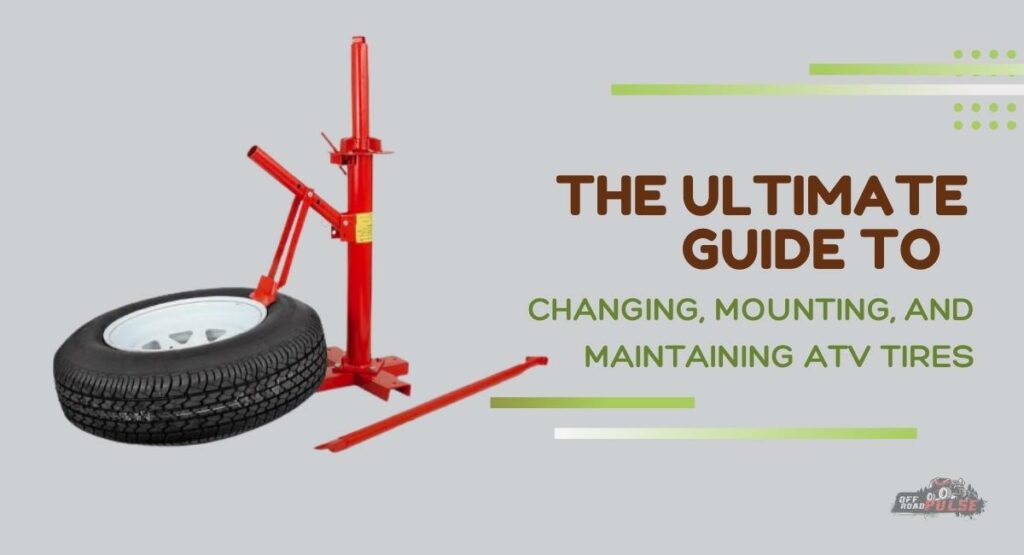All-terrain vehicle (ATV) fans know that proper upkeep of their rides is essential to maximizing their vehicles’ potential and extending their useful lives. Learning how to change the tires on an ATV is an important part of the maintenance that has to be done. This post will provide some insight into how long ATV tires normally lasts and will also describe the step-by-step procedure for changing and mounting ATV tires. In addition, we will analyze the typical lifespan of ATV tires.
How long do the tires on an ATV typically last?
The amount of time that your ATV tires will last depends on a number of factors, including the sort of terrain you drive on, your driving habits, and the quality of your tires. Generally, The lifespan of ATV tires ranges anywhere from three to five years on average. This estimate, however, is open to significant variation depending on the particular circumstances that they are put through.
The type of terrain you ride on might create more wear and strain on your tires than riding on softer ground like sand or grass. To get the most mileage out of your tires over their lifespan, you should select the type of tire that is most suited to the kinds of terrain you ride on most often.
Habits behind the wheel: Driving aggressively, including frequent strong acceleration, quick turns, and sudden stopping, can hasten the wear and tear on tires. Your ATV tires will last longer if you drive more smoothly, so try to make it a priority when you’re behind the wheel.
The quality of the tire is important, as higher-quality tires tend to have a longer lifespan than less expensive options that are of poorer quality. In the long term, making an investment in high-quality tires can help you save money by lowering the number of times you need to replace them.
Maintenance: Having your tires professionally inspected, cleaned, and maintained on a regular basis can extend their useful life by a significant amount. To ensure that your tires wear evenly, you should make sure that they are inflated to the proper pressure at all times and rotate them at regular intervals. It is crucial to make routine checks on your ATV tires to look for symptoms of wear, corrosion, or dry rot. This will help extend the life of your tires and ensure that they function to their full potential.
When not in use, keep your all-terrain vehicle (ATV) in a place that is cool, dry, and out of direct sunshine. Rubber can deteriorate over time when subjected to the damaging effects of heat and sunlight, resulting in dry rot and an early need for tire replacement.

A Step-by-Step Tutorial on How to Replace the Tires on an ATV
The first thing you’ll need when replacing the tires on an ATV is collecting the required tools and supplies. For this project you’ll need;
- Lug wrench
- Tire irons,
- Valve core remover,
- Bead breaker,
- Tire balancer
- Jack or an ATV lift
- An air compressor
Step 1: Apply Parking Breaks
Protect your all-terrain vehicle by first parking it on a level surface and then using the parking brake. If you are working with a jack, position it so that it is underneath the frame or axle of the ATV and lift it until the tire that needs to be changed is clear of the ground.
Step 2: Deflate the tire
In order to remove the old tire, first use the lug wrench to loosen the lug nuts that are attached to the wheel. Deflating the tire requires removing the valve cap and using valve core extractor. After the tire has been deflated, use the bead breaker to remove the bead of the tire. Now, place the tire irons between the tire and the rim, and pry the tire off the rim carefully.
Step 3: Check the Rim
Check the rim for any damage, rust, or debris before installing the new tire. Before mounting the new tire, inspect the rim for any damage, corrosion, or debris. Add a small amount of tire lubricant to the area where the beads sit on the rim.
Step 4: Position the Rim
Installing the new tire requires positioning it on the rim and ensuring that the rotation direction corresponds to the arrow that is printed on the sidewall of the tire. You may pry the tire onto the rim with the tire irons by working in small increments around the circle of the rim.
Step 5: Inflate the tire
After the tire has been properly mounted on the rim, you should then replace the valve core and attach the air compressor so that you can inflate the tire. Inflate the tire to the pressure that is recommended by the manufacturer. This information can typically be found on the sidewall of the tire or in the owner’s manual for your ATV.
Step 6: Use Tire Balancer
In order to properly balance the tire, you must first place the wheel on the tire balancer and then spin the wheel to check for any imbalances. To achieve equilibrium, add weights to the wheel(s) as required.
Step 7: Replace the Wheel
Replace the wheel by placing it onto the hub of the ATV and ensuring that the lug nuts are tightened by hand in a star pattern. After bringing the ATV down to the ground, use the lug wrench to complete the tightening of the lug nuts while continuing to follow the star pattern.
Step 8: Double Check the new Tire
After you have mounted on the rim, ensure the lug nuts are sufficiently tightened, the tire should be inspected to ensure that it is properly inflated and seated on the rim. Do a road test on your ATV to validate that the newly installed tire is in good working order.
Final words
Being able to change and mount ATV tires is a mandatory skill for any person who owns an ATV. You can keep your ATV running at its best and extend the life of your investment by doing routine maintenance on the tires, such as inspecting them periodically and replacing them when necessary. It is also imperative that you make it a habit to examine the owner’s handbook of your ATV whenever you need specific instructions or advice pertaining to your model.




